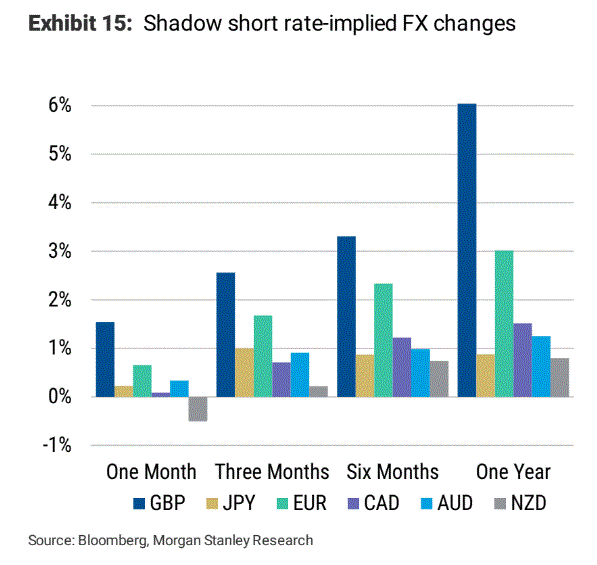All major forex prognosticators produce Australian dollar fair value models. They include the usual variables such as interest rate differentials, terms of trade levels. Westpac’s is typical:
Midpoint of the Westpac A$ fair value is at 0.8040 this week, meaning the A$ is seen as cheap below 0.7750. Given the huge iron ore/ commodity price gains + lower mkt vol, the FX market appears to be underpricing the rise in fair value. pic.twitter.com/jF1VZaLAjN
— Robert Rennie (@Robert__Rennie) May 3, 2021
All of these models work on the same basic themes and generally come out with roughly the same outcome, currently ranging from 80-85 cents.
So, why is the Australian dollar sitting comfortably below these prices? The first reason is that the models may not have adequately accounted for the RBA’s new quantitative easing regime. As Morgan Stanley argued yesterday, if such a regime were parsed into negative interest rates then the AUD is pretty fairly valued already:
The second reason is that the Australian dollar currently faces some atypical risks that are not easily captured in quantitative macro measures based upon previous cycles.
Chief amongst these risks is Australia’s ongoing trade war with China. Although the impact on Australia has so far been small to the point of infinitesimal at the aggregate level, beneath that there is a dramatic narrowing of the trade relationship underway as everything except iron ore and LNG pulls back or outright collapses.
The risk profile of the relationship rises as it narrows, especially since, if it really got the shits, China could simply set a much lower purchases price for iron ore and there is not a whole lot that miners could do about it, which would instantly crash any and all fair value models for the AUD.
Thirdly, markets are rightly discounting the current iron ore surge as temporary. Despite all of the bluster about new commodity supercycles, it is no such thing in iron ore. There is plenty of supply, it’s coming back fast, and demand is going slow just as swiftly as stimulus and Chinese catch-up growth end.
Fourth, markets are also doing a reasonable job of discounting the unusual nature of the COVID cycle. This has two dimensions to it. With the US more fiscally driven than China versus the two previous cycles, the USD is much stronger than it was at similar stages of the cycle. This leadership has been augmented by worldbeating vaccine success, better than just about anywhere else.
In short, traditional Australian dollar fair value models are unable to capture the idiosyncrasies of this cycle and so keep overvaluing the Pacific peso.



